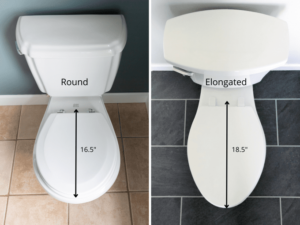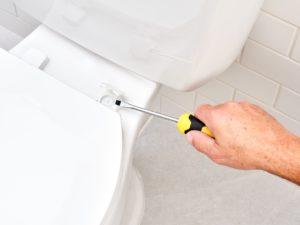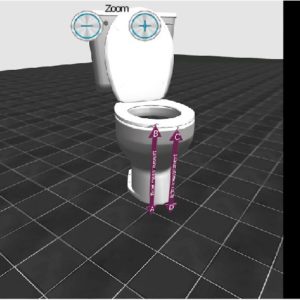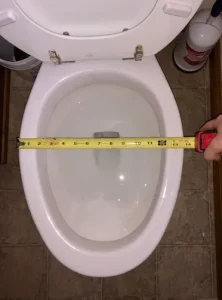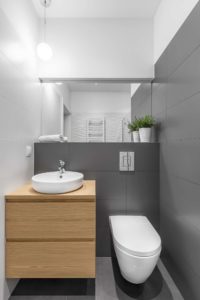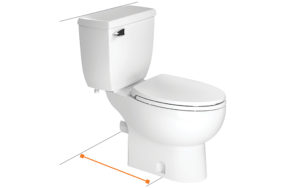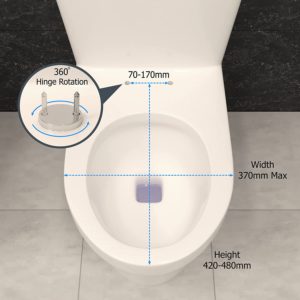It is often seen that when a toilet seat is broken or rattling people eagerly want to replace it with a new best toilet seat but you get to be outdone and buy a toilet seat that looks stylish but does not fit on your toilet bowl. In this article, we will talk about “how to measure a Toilet seat to buy a perfect size for the toilet bowl?”.
Although toilet seats are now available in standard sizes, it is still a good idea to measure your current seat before purchasing a substitute. Begin by measuring the rear to the front of the seat. If the length is approximately 16 inches, choose a regular circular seat (41 cm). Choose an elongated seat if it’s approximately 18 in (46 cm) long. If your toilet is ancient or you’re buying a specialized seat, things get a little more difficult. Irrespective of your scenario, evaluating the seat and selecting the appropriate alternative should be a breeze!
How To Measure a Toilet Seat?
There are 3 different methods to measure a toilet seat to buy a new one perfectly aligned with the toilet bowl.
Method 1: Take the Measurement for a basic seat
Step 1: From either the bolts towards the front, take measurements of the seat
Put one tip of a tape measure on the bolts that attach the seat to the vase on the rear of the seat. Take measurements of the seat by drawing the other end of the line through the very point of the front of the bowl.
- Make sure you check down the middle of the pan.
- To get an actual estimation, align the meter stick with the bolt centers. Pull the acrylic conceals if required to see the bolts. Use a plain-head screwdriver to push off the lids if you can’t pry them up using your fingertips.
- Consider the toilet seat to be a clock. From the middle of each edge, either clockwise measure the length.
Step 2: Determine the distance between both the rear of the seat’s bolts
- If the bolts are hidden under flaps that haven’t been raised, pry them up using your hands or a flat-head screwdriver. Then determine the bolt spread or the distance between the mounting bolts’ centers.
- The usual bolt spread in the United States is 5 12 in (14 cm), however, other versions have spreads of 7 to 10 in (18 to 25 cm). If the dimensions of your toilet aren’t conventional, you might have to buy a seat directly from the manufacturer.
- The typical bolt spread in Europe is around 6 to 6 12 in (15 to 17 cm)
Step 3: Obtain a measurement of the seat’s breadth
- To locate the finest substitute seat, check the breadth. Place one tip of the tape measure in the center of the left edge of the seat and the other side on the right-hand side. Take measurements between the outside borders of the seats’ edges, keeping the tape centered.
- Make sure to take your measurements from the middle of the sides, or even from 9 a.m. to 3 p.m.
- Although sizes are standardized, there may be minor differences across brands. Unless you’re upgrading a seat, gauging the breadth will assist you in finding the best fit.
Method 2: Measuring Toilet For Special Seat
Step 1: Measure the distance between the two bolt holes
- Place the meter stick in the middle of the fastener holes. As directly as possible, calculate the length between both bolt holes’ centers.
- When purchasing a custom seat, bolt width is the most essential parameter. You may need to buy a specialized seat from the toilet’s maker if the bolt spacing isn’t an American standard toilets of 5 12 in (14 cm) or a European standard toilet of 6 to 6 12 in (15 to 17 cm).
Step 2: Take measurements and the width of the basin.
- Bring one end of the measuring tape to the front of the bowl and align it with the centers of the bolt holes.
- The shortest path between the bolt holes and the reservoir is required for bidet connections, elevated seats, seat warmers, and other specialized seats.
- Check online for specs and necessary clearances for an item you’re keen to buy before investing in a specialized seat. You don’t want to waste money on a toilet seat that doesn’t fit your toilet.
Step 3: Whether you’re purchasing a snap-on adapter, measure the current seat
- Accessible elevated chairs for individuals with impairments and toilet training seats are examples of connections. Measure the length and width of your current seat and purchase with the same specifications.
- Although you can identify the form of your toilet merely by gazing at it, you should still examine it to make sure the accessibility or potty learning seat fits snuggly.
- Some additions are hinged-fixed or attached using the current seat’s mounting bolts, but most items clamp onto the seat. Assess the bolt width of your toilet, as well as the entire length of the seat, if needed.
Method 3: Select A New Toilet Seat
Step 1. If the length of your bowl is somewhere around 16 12 inches, choose a circular seat (42 cm)
- Current seat dimensions in the United States are standardized. The seat is circular if it is between 16 and 17 inches (41 and 43 cm). Further than probably, you’ll be able to find a seat from a hardware or household equipment retailer that will suit your toilet.
- With your human eye, one can generally discern the difference between round and elongated seats but never pays to double-check. You might be able to avoid making a second visit to the shop if you take samples.
Step 2. If the bowl’s diameter is approximately 18 12 inches, use an extended seat (47 cm)
The typical size for extended chairs in the United States is 18 to 19 12 inches (46 to 50 cm). Elongated seats are easily identified, but like circular seats, it’s a good idea to find the length, bolt spread, and breadth of the seat to be cautious.
Step 3. If you have a Euro toilet, get a seat that fits the bowl form
European bowls are often rounded, pointy, or D-shaped, and these forms are pretty straightforward to recognize. Because the normal length for each form is around 17 in (43 cm), obtaining a new seat simply comes down to knowing the right shape.
Step 4. If your toilet isn’t standard, look up the manufacturer and model
- While current toilet seat measurements are regulated, you may find that the proportions of your ancient toilet are entirely different. Older seats could be available online or via specialist plumbing vendors. Look for the brand and model of your toilet online, or use phrases like “toilet seat 8 in (20 cm) bolt spread.”
- A few modern versions have non-standard proportions as well. Corresponding toilet seats may be found online or ordered straight from the manufacturer of these toilets.
- Remove the tank lid, turn it over, and check for a brand name and product code to determine your toilet’s model number.
- Take a flashlight and check inside the tank for the make and model if the model cannot be found on the tank lid.
Read Also- Best Portable Composting Toilet: All The New Guide For 2022
Conclusion!
Here it is! This article concludes here. We tried our best to give you all the information about “ How to Measure a Toilet seat?” In this article, we told you about 3 different methods for 3 different toilet seats and their measurement tricks. If you are willing to buy a new toilet seat for your old toilet because the old toilet seat gets damaged then the measurement plays a crucial part before buying one. If our article helped you with its informative data then let us know in the comment section below.
FAQs
What is the standard toilet seat size?
The standard size of a toilet seat must be 18 inches in height and 10 to 13 inches in width.
Do all toilet seats fit all toilets?
No, not all sizes are the same. You just measure the size before buying a toilet seat.
How do I know what kind of toilet seat I have?
There are two kinds of toilet seats: round and elongated. Just measure the length and the breath if it measures differently than simply it is an elongated one.
